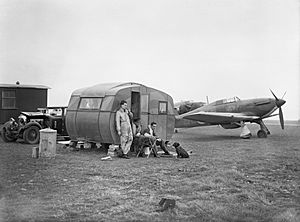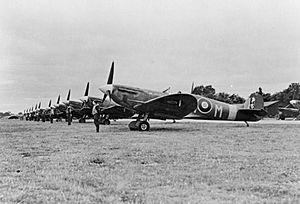John Marlow Thompson facts for kids
Quick facts for kids
John Marlow Thompson
|
|
|---|---|
| Born | 16 August 1914 Keynsham, Somerset |
| Died | 23 July 1994 (aged 79) Brighton, Sussex |
| Allegiance | United Kingdom |
| Service/ |
Royal Air Force |
| Years of service | 1934–1966 |
| Rank | Air Commodore |
| Commands held | Military Air Traffic Organisation (1962–66) Director of Air Defence (1958–60) RAF Leeming (1957–58) No. 338 Wing RAF (1944) RAF Hal Far (1943–44) No. 350 Squadron (1941–42) No. 131 Squadron (1941) No. 111 Squadron (1940) |
| Battles/wars | Second World War |
| Awards | Commander of the Order of the British Empire Distinguished Service Order Distinguished Flying Cross & Bar Air Force Cross Military Cross, First Class (Belgium) |
John Marlow Thompson (born August 16, 1914 – died July 23, 1994) was a brave pilot in the Royal Air Force (RAF). He was known as a "flying ace" during the Second World War. This means he shot down at least eight enemy aircraft.
Thompson was born in Somerset, England. He joined the RAF in 1934. After his training, he became a pilot in No. 29 Squadron. When the Second World War began, he took command of No. 111 Squadron. He led them during the Battle of France and the Battle of Britain.
During these battles, he achieved many aerial victories. In 1942, he went to the Middle East and then to Malta. He led fighter wings there for several months. After the war, he stayed in the RAF. He retired in 1966 as an Air Commodore. He later worked in civil aviation and golf club management. He passed away in Brighton at age 79.
Contents
Early Life and RAF Training
John Marlow Thompson was born on August 16, 1914, in Keynsham, Somerset. He went to school at Bristol Grammar School. In March 1934, he joined the Royal Air Force (RAF) as a pilot officer.
The next month, he started his pilot training. He finished his training in March 1935. He then joined No. 29 Squadron. In August, he moved to No. 151 Squadron. A month later, he was promoted to flying officer. By September 1937, he was a flight commander.
World War II Service
In January 1940, the Second World War was already happening. Thompson was promoted to squadron leader. He was given command of No. 111 Squadron. This squadron flew Hawker Hurricane fighters. They were based in Scotland.
In May 1940, the squadron moved to Northolt in southern England. They were ready for action.
Fighting in France
Thompson first saw combat during the German invasion of France. He led No. 111 Squadron on patrols over France. On May 18, he shot down two Messerschmitt Bf 110 heavy fighters. One of these was confirmed.
The next day, his Hurricane was damaged. He was fighting Heinkel He 111 bombers and Bf 110 fighters. He claimed one He 111, but it could not be confirmed. He had to land his plane near Valenciennes. British soldiers helped him get back to England.
Thompson returned to his squadron. He flew missions to help British soldiers leave Dunkirk. On May 31, he shot down a Messerschmitt Bf 109 fighter. This victory was not confirmed. On June 11, he destroyed another Bf 109. He also damaged a Junkers Ju 88 bomber.
Defending Britain
During the Battle of Britain, No. 111 Squadron was based at Croydon. They patrolled the English Channel. They also fought in the skies over southeast England. On July 10, Thompson damaged a Dornier Do 17 bomber. He damaged another the next day.
On August 13, he destroyed one Do 17 and damaged another. Two days later, he shot down a Do 17 and a Bf 110. He also damaged a Bf 109. On August 16, he shot down another Do 17. For his bravery, he received the Distinguished Flying Cross (DFC) in September.
The award said he led his squadron very well. Under his leadership, 81 enemy aircraft were destroyed. He personally shot down eight and damaged at least six enemy planes.
Channel Front Operations
In October 1940, Thompson moved to a staff job. In June 1941, he took command of No. 131 Squadron. This was a new squadron with Belgian pilots. They flew Supermarine Spitfire fighters.
Thompson trained the unit until October. The next month, he helped form No. 350 Squadron. This was a special unit of Belgian fighter pilots. They flew Spitfires and protected ships. Thompson led this squadron until March 1942. He later received the Belgian Military Cross for his work.
Fighting in Malta
Thompson was promoted to wing commander. He went to Malta in July. He became the temporary wing leader of the Takali Fighter Wing. Later, he led the Hal Far Fighter Wing. On August 27, he helped destroy a Ju 88.
During the intense German air attacks on Malta in October, Thompson had more victories. He shot down a Bf 109. He damaged another Bf 109 the next day. On October 14, he damaged a Bf 109 and destroyed a Ju 88.
In December, he received a Bar to his DFC. This meant he got a second DFC award. He then took command of the Luqa Fighter Wing. He was the only RAF officer to command all three of Malta's fighter wings. In May 1943, he received the Distinguished Service Order.
The award stated he had a great record. He fought in France and the Battle of Britain. For nine months, he flew missions from Malta. He played a key part in defending the island. He also led fighter-bombers in attacks on enemy targets.
Later War Service
In June, Thompson moved to RAF headquarters in Malta. He was in charge of training. He then became ill and was in the hospital. After recovering, he commanded the RAF station at Hal Far.
He also led a fighter wing in Sicily for a short time. Then he took command of No. 338 Wing in Algiers. By August 1945, he was a sector commander in England.
By the end of the war, Thompson had destroyed eight enemy aircraft. He also shared in destroying two more. He damaged seven enemy planes.
After the War
After the war, Thompson attended the RAF Staff College. He then worked in Germany. In June 1948, the Russians blocked Berlin. Thompson helped organize the Berlin airlift. This was a huge effort to fly supplies into the city.
After three years in Germany, he became a wing leader in England. He flew Gloster Meteor fighter jets. In January 1952, he received the Air Force Cross. In July 1953, he was promoted to group captain.
He became a senior air staff officer. He then commanded the RAF station at Leeming. In 1955, he was appointed a Commander of the Order of the British Empire. In December 1958, he became the Director of Air Defence. He was promoted to air commodore the next year.
His last job was commanding the Military Air Traffic Organisation. He retired from the RAF in September 1966.
Later Life and Retirement
After retiring, Thompson worked in aviation for a few years. He was a general manager in Saudi Arabia. He also worked as an aviation consultant.
In 1969, he became the secretary of a golf club in England. Later, he was the secretary of the Monte Carlo Golf Club for 11 years. He retired in 1983. He lived in Sussex until he passed away in Brighton on July 23, 1994.



